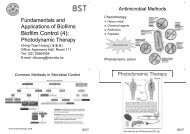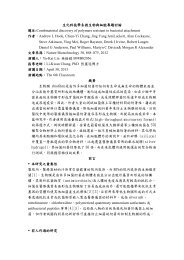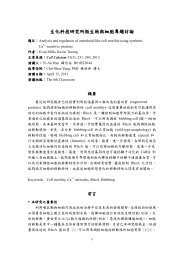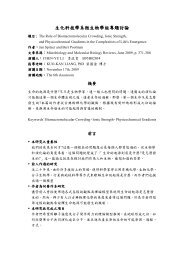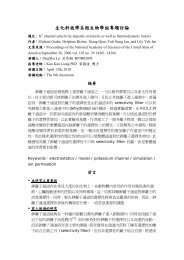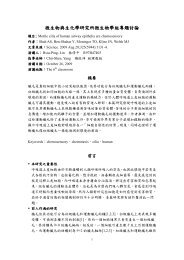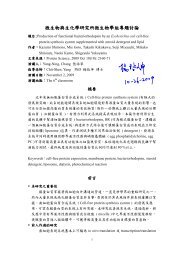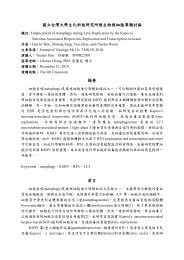What is Biofilm?
What is Biofilm?
What is Biofilm?
Create successful ePaper yourself
Turn your PDF publications into a flip-book with our unique Google optimized e-Paper software.
Toluidine Blue-Mediated Photodynamic<br />
Effects on Staphylococcal <strong>Biofilm</strong>s<br />
Mrinalini Sharma, Livia V<strong>is</strong>ai, Francesca Bragheri, Haria Cr<strong>is</strong>tiani,<br />
Pradeep Kumar Gupta, and Pietro Speziale<br />
Antimicrobial Agents And Chemotherapy, 52(1): 299-305, 2008<br />
Speaker: I-Lun Chiang<br />
Adv<strong>is</strong>er: Ching-Tsan Huang, PhD<br />
Date: 2008.12.9<br />
1
<strong>Biofilm</strong>s are everywhere!<br />
<strong>Biofilm</strong> on rock<br />
Had you ever slipped on a rock?<br />
<strong>Biofilm</strong> on pipe<br />
<strong>Biofilm</strong> in toilet<br />
cleaned a clogged drain pipe or toilet?<br />
2
<strong>What</strong> <strong>is</strong> <strong>Biofilm</strong>?<br />
a structured community of microorgan<strong>is</strong>ms<br />
Mushroom-like conceptual model<br />
a living or nonliving surface.<br />
extracellular matrix<br />
3
How do bacterial biofilms develop?<br />
pili<br />
van der Waals forces<br />
extracellular<br />
polymeric<br />
substance<br />
(EPS)<br />
quorum sensing<br />
(By Dr. Ghigo Jean-Marc)<br />
4
Staphylococcal biofilms<br />
Staphylococcus aureus biofilm<br />
- Gram (+) bacteria<br />
Staphylococcus epidermid<strong>is</strong> biofilm<br />
- Gram (+) bacteria<br />
5
Common Sites of Staphyloccocal <strong>Biofilm</strong> Infections<br />
Catheter<br />
Infection<br />
Artificial hip implant<br />
6<br />
peridontal d<strong>is</strong>ease<br />
Mechanical heart valves<br />
Wound infection
Staphylococcus aureus<br />
?<br />
─ invade the wound after surgical procedure<br />
S. aureus<br />
?<br />
Penicillin (1940s)<br />
2 years<br />
Vancomycin-res<strong>is</strong>tant<br />
S. aureus (VRSA)<br />
Methicilin (1960)<br />
Vancomycin<br />
Penicillin-res<strong>is</strong>tant<br />
S. aureus<br />
1 year<br />
Methicillin-res<strong>is</strong>tant<br />
S. aureus (MRSA)<br />
Vancomycin-intermediate<br />
S. aureus (VISA)<br />
The d<strong>is</strong>covery of new antibiotics might not catch up with the<br />
appearance of antibiotics res<strong>is</strong>tance.<br />
7
Extracellular pulymeric substance<br />
(EPS) protect from phagocytos<strong>is</strong><br />
<strong>Biofilm</strong><br />
Antibiotics<br />
res<strong>is</strong>tance<br />
res<strong>is</strong>tant to phagocytos<strong>is</strong><br />
Antibiotics<br />
res<strong>is</strong>tance<br />
Extracellular<br />
matrix<br />
protection<br />
8
<strong>Biofilm</strong> res<strong>is</strong>tance mechan<strong>is</strong>ms<br />
9
Strategies of <strong>Biofilm</strong> Control-<br />
1. Prevention <strong>is</strong> better than cure<br />
2. Removing or Killing<br />
Traditional ways<br />
Stop growth - by antimicrobial agents<br />
Block attachment - by changing surface material<br />
Promote detachment -by surfactants<br />
Mechanical removal - by ultrasonic device<br />
Kill - by biocide, chemical agents<br />
Toxicity ?<br />
But some ways cannot be carried out in hospitalized patients…<br />
10
Besides traditional ways…<br />
• Is there any alternative way to<br />
inhibit the bacteria growth in biofilms?<br />
There <strong>is</strong> one way…<br />
11
Photodynamic Therapy (PDT)<br />
Three factors of PDT: Light , PS , Oxygen<br />
Light<br />
Photosensitizer<br />
(excited state)<br />
Excitation<br />
Fluorescence<br />
Photosensitizer<br />
(ground state)<br />
e -<br />
1 O2<br />
3 O2<br />
Type I<br />
ROS<br />
( OH. H 2 O 2 O 2 - )<br />
Type II<br />
singlet oxygen<br />
12<br />
Cellular<br />
toxicity
The difference of PDT effect between<br />
planktonic cells and biofilms<br />
S. aureus planktonic cells S. aureus biofilms<br />
20 μg/ml<br />
MC 540<br />
All-killed<br />
light dose<br />
no MC 540<br />
5 μg/ml<br />
MC 540<br />
10 μg/ml<br />
MC 540<br />
15 μg/ml<br />
MC 540<br />
Photosensitizer: Merocyanine 540 (MC540)<br />
no MC 540<br />
5 μg/ml<br />
13<br />
10 μg/ml<br />
15 μg/ml<br />
20 μg/ml<br />
All-killed<br />
light dose<br />
(Lin, H. Y. et al. 2004)
Extracellur matrix in biofilms<br />
Hindrance of the penetration of light and<br />
the uptake of photosensitizer<br />
drugs<br />
polysaccharide intercellular adhesion (PIA)<br />
extracellular polymeric substance (EPS)<br />
How to solve th<strong>is</strong> problem?<br />
14
Increase the permeability<br />
Metal chelators<br />
EDTA and tetrasodium EDTA (TEDTA)<br />
TEDTA<br />
amine group<br />
( salt form of EDTA, better solubility )<br />
carboxylate group<br />
EDTA<br />
15
How Metal Chelators d<strong>is</strong>persing the<br />
structure of a biofilm?<br />
• The sequestration of divalent cations, such as<br />
Ca 2+ and Mg 2+ , are important for maintaing the<br />
integrity of EPS in the biofilm.<br />
Mg 2+<br />
Ca 2+<br />
Mg2+ Mg2+ Ca2+ Ca2+ Ca2+ TEDTA<br />
16
The purpose of th<strong>is</strong> study<br />
1. To examine the photodynamic effects of TBO on<br />
the viability and structure of staphylococcal<br />
biofilms.<br />
2. To investigate the effect of TEDTA pretreatment<br />
on the efficacy of the photodynamic inactivation of<br />
staphylococcal biofilms.<br />
17
The framework of th<strong>is</strong> study<br />
CFU counting<br />
Survival Fraction<br />
No TEDTA<br />
pretreatment<br />
<strong>Biofilm</strong><br />
formation<br />
Confocal Laser Scanning<br />
Microscopy (CLSM)<br />
TEDTA<br />
pretreatment<br />
Photodynamic therapy with 40 μM TBO<br />
S. aureus LP<br />
S. epidermid<strong>is</strong> 1457<br />
Scanning electron<br />
Microscopy (SEM)<br />
Viability Morphology<br />
Effect of TBO with light dose Effect of TEDTA treatment<br />
18
Materials and Methods<br />
Stapylococcal biofilms<br />
S. aureus LP/ S. epidermid<strong>is</strong> 1457<br />
ROS<br />
T<strong>is</strong>sue<br />
O 2<br />
CFU count (TSA)<br />
+TEDTA<br />
( 1 hour )<br />
640 nm<br />
diode laser<br />
Survival Fraction<br />
Photosensitizer (TBO)<br />
Incubation time: 30 min<br />
CLSM images<br />
SEM images<br />
19
Results<br />
Survival fraction <br />
or<br />
No TEDTA<br />
pretreatment<br />
CFU of (S+ L + )<br />
CFU of (S + L - )<br />
CFU of (TEDTA + S + L + )<br />
CFU of (TEDTA + S - L - )<br />
S - L -<br />
S + L -<br />
S + L +<br />
TEDTA + S - L -<br />
TEDTA + S + L<br />
-<br />
TEDTA + S + L +<br />
S:sensitizer (TBO:40 μM)<br />
L: light dose (100 J/cm 2 )<br />
TEDTA: 20 mM<br />
20<br />
TEDTA<br />
pretreatment<br />
TBO itself do no harm to staphylococcal biofilms
Confocal laser scanning microscopy<br />
(CLSM)<br />
• Use Live/Dead BacLight Bacterial Viability Kits<br />
-Two fluorescent nucleic acid stains:<br />
SYTO9 : green(live)<br />
Propidium iodide(PI): red(dead)<br />
CLSM image<br />
Cross section<br />
21<br />
Cross<br />
section
22<br />
SEM<br />
images<br />
green(live)<br />
red(dead)<br />
CLSM<br />
images<br />
S. epidermid<strong>is</strong><br />
Experiment<br />
conditions<br />
S. aureus<br />
CLSM<br />
images<br />
SEM<br />
images<br />
TEDTA(-)<br />
Dark<br />
TEDTA(-)<br />
TBO(40 μM)<br />
100 J/cm 2<br />
TEDTA(-)<br />
TBO(40 μM)<br />
200 J/cm 2<br />
TEDTA(+)<br />
Dark<br />
TEDTA(+)<br />
TBO(40 μM)<br />
100 J/cm 2
Staphylococcal<br />
Antibiotics Antibiotics treatment<br />
res<strong>is</strong>tance<br />
biofilms<br />
Immune Res<strong>is</strong>tant system to<br />
Phagocytos<strong>is</strong><br />
Mg 2+<br />
Ca 2+<br />
Ca2+ Mg2+ Ca 2+<br />
Ca 2+<br />
Photodynamic inactivation<br />
No Hindrance TEDTA of penetration TEDTA<br />
pretreatment pretreatment<br />
Pretreatment of Metal<br />
chelater<br />
Mg 2+<br />
Photodynamic therapy<br />
Mg 2+<br />
?<br />
Enhance the efficacy of PDT<br />
Ca2+ Mg2+ Mg 2+<br />
Ca 2+<br />
Mg2+ Mg2+ Ca2+ Ca2+ Ca2+ Photodynamic inactivation<br />
Effect of TBO with light dose Effect of TEDTA treatment<br />
The main cause of cell death D<strong>is</strong>perse biofilm structure<br />
23
The End<br />
Thanks for your attention!!<br />
Special thanks to Prof. Huang !<br />
24
Cell-cell communication<br />
• Cells in a biofilm “talk” to each other via<br />
quorum sensing.
Metal Chelator-Tetrasodium EDTA<br />
• TEDTA <strong>is</strong> a novel central venous catheter lock<br />
solution against biofilm.<br />
(Infection Control and Hospital Epidemiology Vol.26 N0.6)<br />
27
Photodynamic therapy (PDT)<br />
S 1*<br />
S 0<br />
Photosensitizer (excited state)<br />
intersystem<br />
crossing<br />
T 1*<br />
3P<br />
Photosensitizer (ground state)<br />
triplet state<br />
singlet oxygen<br />
1 O2<br />
3 O2<br />
28<br />
http://chemgroups.ucdav<strong>is</strong>.edu/~smith/PDT_Research/PDT.html
Photosensitizers used in PDT<br />
Amphiphilic ,<br />
cationic<br />
Lipophilic ,<br />
anionic<br />
29<br />
Hydrophobic– helps penetration in<br />
cellular membrane<br />
Hydrophilic – helps diffusion.<br />
MC 540
Wavelength Absorption of<br />
Photosensitizer<br />
• Best if absorb at longer wavelengths<br />
• Longer wavelength em<strong>is</strong>sions can penetrate<br />
t<strong>is</strong>sue farther.<br />
• Decreases probability of damage to surrounding<br />
t<strong>is</strong>sue.<br />
• Must have enough energy to excite O 2<br />
30
Light source of PDT<br />
• LED (Light-emitting diode):<br />
-coherent<br />
-long useful lifetime<br />
-high photoelectric conversion efficiency<br />
• Laser<br />
-noncoherent<br />
-specific wavelength high intensity<br />
-low divergent effect<br />
31
<strong>Biofilm</strong>-associated infections<br />
32
PDT has better effect on Gram(+)<br />
bacteria due to the cell wall structure<br />
Thick peptidoglycan cell wall integrated by several<br />
lipoteichoic acid forms many holes<br />
Photosensitizers can pass through Gram positive<br />
bacterial cell wall easier.<br />
barrier<br />
33
S. aureus v.s. S. epidermid<strong>is</strong><br />
Staphylococcus aureus Staphylococcal epidermid<strong>is</strong><br />
Culture medium TSB (Tryptic soy broth) TSB (Tryptic soy broth)<br />
Gram-staining Gram(+) Gram(+)<br />
Biochemical<br />
character<strong>is</strong>tics<br />
catalase-positive<br />
coagulase-positive<br />
catalase-positive<br />
coagulase-negative<br />
habitat facultative anaerobe facultative anaerobe<br />
color golden-yellow white



